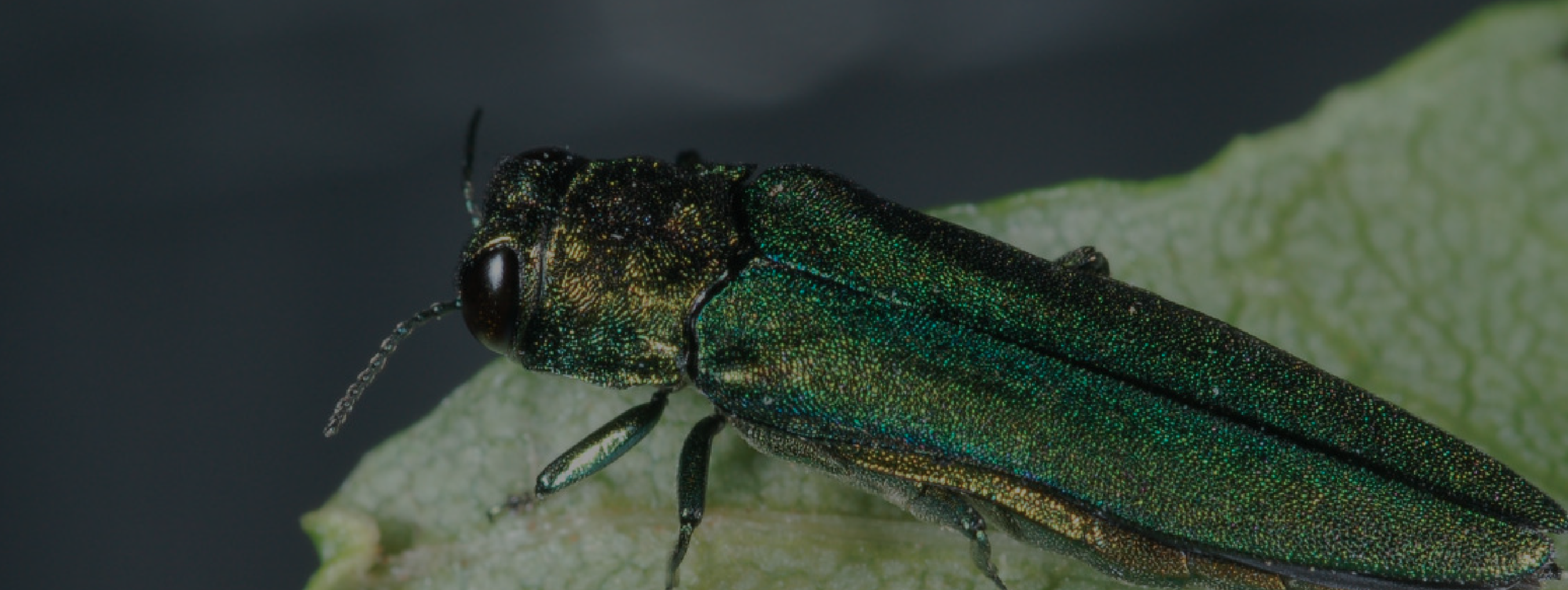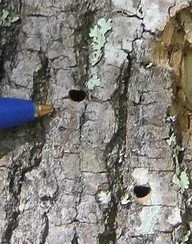
Invasive Species | Forest Pests
Emerald Ash Borer
Emerald Ash Borer
(Agrilus planipennis)
French common name: Agrile du frêne
A wood-boring beetle that has caused the death of millions of Ash trees across Canada and the United States since its detection in 2002. Originating from Eastern Asia, this forest pest exclusively targets Ash trees.
Emerald Ash Borer
Emerald Ash Borer (EAB) is a wood-boring beetle that has caused the death of millions of Ash trees across Canada and the United States since its detection in 2002. Originating from Eastern Asia, this forest pest exclusively targets Ash trees, including the three species found in New Brunswick: Black, White, and Green Ash.
Infested trees have a 99% mortality rate 8-10 years after EAB infestation (CFIA, 2021). EAB was first identified in New Brunswick in Edmundston in 2018, Oromocto and Moncton in 2019, and most recently in Fredericton in 2021. Introduction to New Brunswick is thought to have occurred during the movement of firewood or wood products that were infested with EAB.
Species information
Emerald ash borer (Agrilus planipennis), is a small beetle species native to Asia. It is approximately the size of a grain of rice (8-10mm) and is an iridescent/metallic emerald green color (although not to be confused with other native emerald beetles). EAB first appeared in Canada in 2002 in Windsor, Ontario and is suspected to have entered the province through wood packaging or pallets from Detroit, Michigan.
Life Cycle
Adult beetles only feed and lay eggs on Ash trees. Although the adults feeding on the ash leaves causes some damage, most of this species’ impact takes place in its larval stage. After mating, the female beetles lay their eggs in the bark crevices of the host ash tree; once the eggs hatch, the larvae chew into the ash tree where they feed on the vascular layer of the tree that allows the movement of nutrients and water in the tree.
After overwintering inside the ash tree, the larvae pupate into adult beetles which then emerge through the bark, leaving a characteristic “D” shaped exit hole. These adults will mate and lay their eggs directly on the bark of Ash trees, and the cycle will continue the following year.
Signs of infestation
You are more likely to notice signs of EAB presence than you are to see the actual beetles. Some common signs of EAB infestation include;
Crown Dieback: Loss of leaves and dead branches around the top and outsides of the tree silhouette may indicate EAB infestation, especially if multiple Ash in the same area are showing these signs of decline
Blonding: Woodpeckers will strip pieces of bark off infested trees to reach the EAB larvae underneath, resulting in smoother, light-coloured sections on the trunk
Epicormic Shoots (ie. ‘suckers’): Ash trees may also produce shoots of new growth near the base of tree in response to EAB infestation
D-shaped Exit Hole: As adult beetles burrow out of Ash trees, they leave a smooth edged “D”-shaped exit hole in the bark
Larval Galleries: Infested Ash will have distinct “S”-shaped tracks under the bark from larvae eating through the wood. These are difficult to see if the tree is still standing.
Impacts of Emerald Ash Borer
Environmental impacts
Ash trees infested with EAB are severely impacted within 1-2 years and have a 99% mortality rate in the 8-10 years following infestation (CFIA, 2021). Ash trees are a significant tree species in New Brunswick and are common in urban and rural forested and stream-side areas. The loss of these Ash trees from forest ecosystems will reduce tree cover leading to increased ground temperature, loss of habitat for native wildlife, and changes to natural forest functioning. Impacted environments like these can allow more invasive species to establish.
Green and Black Ash (Fraxinus pennsylvanica, Fraxinus nigra) are also important tree species in stream-side habitats and help secure shorelines; the loss of these trees could result in soil erosion into streams and changes in water temperature, which can impact native fish and other aquatic species.
Social impacts
Ash trees are an important Canadian species that have been present in our forest ecosystems for hundreds of years. Black Ash (Fraxinus nigra) also has great cultural significance for many Indigenous peoples in Canada for basket weaving as it has soft wood that easily separates into layers. See https://friendsofmurphyspoint.ca/2021/06/21/the-natural-and-cultural-significance-of-the-black-ash/ for more on the natural and cultural significance of Black Ash in Canada.
The loss of Ash trees will also have impacts in urban environments, as they provide many ecosystem services. In urban centers, large trees like Ash act as windbreaks and regulate temperature by providing shelter and shade, and their root structures and leaves can mitigate water runoff and intercept urban pollution.
Economic impacts
As of 2012, the Canadian Food Inspection Agency had already spent over $30 million to manage the invasion of EAB and has cut over 30,000 trees to slow the spread of the beetle. In Ontario where EAB has invaded, the total spent by municipalities in just one year to treat Emerald Ash Borer was $12,083,395 (Invasive Species Centre, 2020).
The loss of the ecosystem services provided by Ash trees can also have an economic impact, with impacts to forest productivity, temperature control, and runoff mitigation. See https://www.americanforests.org/blog/much-forests-worth/ for more on how forests can provide real economic savings in urban and rural areas.
What do I do if I find/suspect Emerald Ash Borer (EAB)?
New infestations of EAB should be reported to Canadian Food Inspection Agency (CFIA) at 1-866-463-6017 or to your local Municipality.
Be sure to include the following with your observation:
Location (be as exact as possible)
Date of observation
Photos if possible, and a description of the signs of infestation you have observed
Your contact information for follow-up if needed
See the CFIA Emerald Ash Borer webpage for more information
Removing infested Ash trees
Removal of dead or dying branches may help slow the spread of EAB, and in some cases, removal of the entire tree is necessary and can be done pre-emptively depending on the landowner's preference and local EAB presence. Large scale removal of Ash trees is typically completed by municipalities, as falling branches and dying trees are a threat to public safety.
If you do trim or remove parts of Ash trees on your property, do not move the cut wood off-site; burn, compost, or use the wood on-site instead to avoid the further spread of EAB larvae and beetles through infested wood. If you must move the material, chip it first and take it directly to the nearest yard waste facility. Do NOT move material elsewhere to use as firewood or building materials (eg. at camping, at cottages) as this can transport EAB much father than it can naturally move.
NBISC strongly recommends the use of professional tree felling services for removing Ash wood to prevent risk of serious injury. Trees infested with EAB may look relatively healthy from the outside but could require special skill and equipment to remove safely. Use caution when removing or cutting any tree clippings or branches.
Firewood restrictions
The Canadian Food Inspection Agency is responsible for regulating areas in Canada where EAB is suspected or has been confirmed to be present. These regulations limit the movement of Ash and all firewood products within designated areas. This means it is illegal to move firewood of any kind into and out of these areas (i.e. cutting firewood at home and using it in a campground in another part of the province). This is often how wood-based pests like EAB spread further and faster than their natural movement allows.
The following counties are regulated in New Brunswick:
Madawaska County
Victoria county
Carleton county
York county
Sunbury county
Queens county
Kings county
Westmorland county
Albert county
Don't move firewood!
The movement of infested firewood is one of the main ways invasive forest pests like Emerald Ash Borer are moved to new areas. On their own, Emerald Ash Borer beetles can only fly up to a 15km radius, but we inadvertently move them much farther and much faster when they hitch a ride in firewood
That is why it is always best practice to buy your firewood as close to where you will burn it as possible: BUY LOCAL, BURN LOCAL to help protect New Brunswick’s forests and urban trees!
New Brunswick Community Ash Tree Inventory
Do you have an Ash tree on your private property? We want to know!
We are asking the public to submit any Ash trees they have on their property to the online citizen-science website iNaturalist.ca to help use create a New Brunswick Community Ash Tree Inventory. Doing so will help contribute to a better understanding of where Ash trees are located within New Brunswick, so that partners and municipalities can better plan Emerald Ash Borer management strategies.
See https://www.inaturalist.org/observations?project_id=101168 to submit an observation of an Ash tree in your community!














